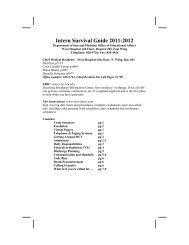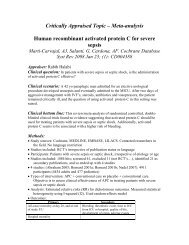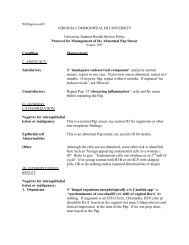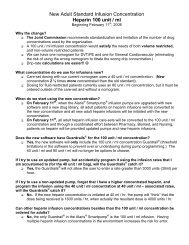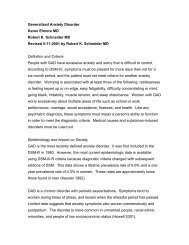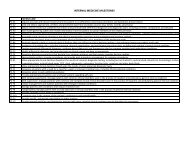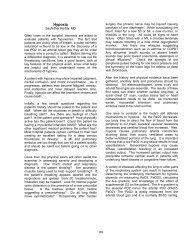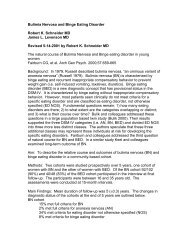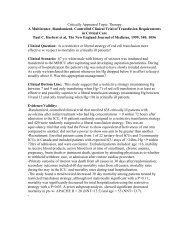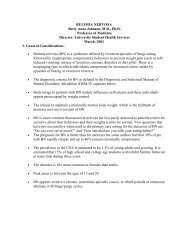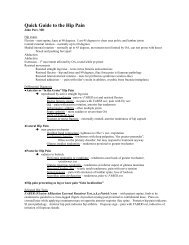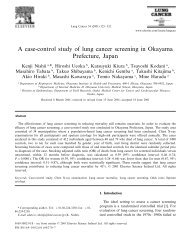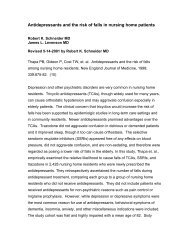Hepatitis B Infection Time Course of Serologies:
Hepatitis B Infection Time Course of Serologies:
Hepatitis B Infection Time Course of Serologies:
You also want an ePaper? Increase the reach of your titles
YUMPU automatically turns print PDFs into web optimized ePapers that Google loves.
<strong>Hepatitis</strong> B <strong>Infection</strong><br />
<strong>Time</strong> <strong>Course</strong> <strong>of</strong> <strong>Serologies</strong>:<br />
HAV IgM Appears with symptoms and ND in 6-12 months<br />
HBsAg Appears 1-20 weeks <strong>of</strong> inoculation and disappears 12-20weeks after onset <strong>of</strong> 90% <strong>of</strong><br />
cases. No present with vaccination. Persistence >6 months in defines carrier state<br />
HBsAb Appears several weeks/months after normalization <strong>of</strong> ALT and disappearance <strong>of</strong> HBsAg.<br />
Coexistence <strong>of</strong> HbsAb and Ab in ~24% regarded as carriers<br />
HBcAb Appears within 2 weeks <strong>of</strong> HBsAg. Isolated serology in 3 situations (1) Serologic<br />
window, primarily IgM (2) Years after resolved acute HBV when HBsAb ND (3) Chronic<br />
HBV when HBsAg titer ND. IgM may flare in chronic<br />
HBeAg Considered marker <strong>of</strong> replication and infectivity. Appears within 1 week <strong>of</strong> HBsAg.<br />
Disappears 3-6 weeks after ALT peak. Should correlate with HBV DNA, but mutant<br />
HBV strains may not produce eAg<br />
HBeAb Indicates decreasing infectivity. Also seroconversion <strong>of</strong> eAg to eAb is another marker for<br />
acute infection (esp. with HBsAg+ cases)<br />
HBV DNA Detectable within 1 week <strong>of</strong> infection. Indicator <strong>of</strong> viral replication. Important for<br />
assessment <strong>of</strong> candidacy for treatment<br />
Hep C Ab Appears 2-3 weeks after exposure (detected in 80% within 15 weeks). Positive results<br />
should be verified with PCR.<br />
Hep C PCR Detectable as early as 1-2 weeks after exposure. Appears with acute infection and used to<br />
diagnosis prior to seroconversion.<br />
HDAb 1-10% <strong>of</strong> HBsAg carriers. HDV IgM Ab documents acute infection and present in first 7-<br />
14 days. Low titers <strong>of</strong> IgG indicated subacute HDV and high titers <strong>of</strong> IgG indicated<br />
chronic infection<br />
Definitions <strong>of</strong> HBV <strong>Infection</strong><br />
• Chronic Hep B: Chronic inflammatory disease <strong>of</strong> the liver.<br />
o Diagnostic criteria:<br />
• HBsAg positive >6 months<br />
• Serum HBV DNA >10 5<br />
• Persistent/intermittent elevation <strong>of</strong> transaminases<br />
• Liver biopsy with chronic hepatitis (necroinflammatoyr score > 4)<br />
o Classified as either HBeAg+ and HBeAg- chronic hepatitis B<br />
• Inactive HBsAg Carrier State: Persistent HBV infection <strong>of</strong> the liver without significant ongoing<br />
inflammatory disease<br />
o Diagnostic criteria<br />
• HBsAg positive > 6 months<br />
• HBeAg negative, HBeAb positive<br />
• Serum HBV DNA levels
• Persistently normal ALT/AST<br />
• Liver biopsy without hepatitis (necroinflammatory score 50 acute HBV in US<br />
• Chronic <strong>Hepatitis</strong> B: HBeAg+ with HBV DNA + and normal ALT<br />
o ALT q3-6 months<br />
• If ALT > 1-2 x normal, recheck Q1-3 months<br />
• If ALT > 2x normal for 3-6 months and HBeAg+, HBV DNA >10 5 , consider<br />
liver biopsy and treatment (IFNα, Lamivudine, Adefovir)<br />
• HCC Screening with AFP +/- ultrasound yearly<br />
• Inactive HBsAg Carrier State<br />
o ALT Q6-12 months<br />
o If ALT >1-2x , check serum HBV DNA level and exclude other causes <strong>of</strong> liver disease<br />
o Consider screening for HCC with AFP



